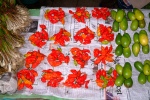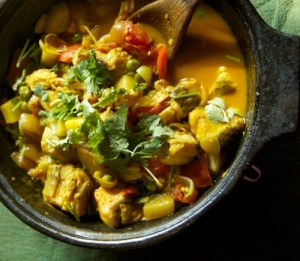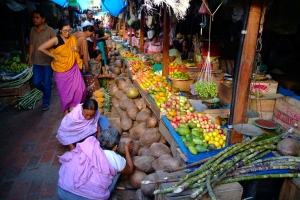Today Manipur was in news. I saw a big article on Mary Kom in a national news paper; a few days back she was walking the ramp, a few weeks prior to that she was a proud recipient of the Olympic bronze backing her world championship title that she has won five times. It is indeed a proud moment for me – an obsessive North East India enthusiast.
Today Manipur was in news again. The news piece said: At least seven Assam Rifles personnel were injured in a bomb blast in Bishenpur district of Manipur on Sunday when the para-military personnel were jogging on a road, official sources said.
Bittersweet morning it turned out to be.
There was one thing about the article in the morning that took me back to my own experiences in Manipur. Mary said, “In Manipur men and women are treated equally.” I would make a slight change in the sentence and say, women have ensured that they are treated equally. What I see in Manipur are strong willed women; resilient yet fierce.
Ima Keithel: Especially for those who have never heard of or visited this amazing market in Imphal, the capital of Manipur, this is a rock solid example of women taking matters into their own hands. This is perhaps, the only market in the world, where all stalls are run by women. The name is self explanatory – Ima (meaning mother) Keithel (meaning market). The exuberance of the products sold, from vegetables, meats and flowers to handicrafts to utensils go hand in hand with the spirit of these 3000 women, of all age groups, who put up their stalls every morning. For these enterprising women, this is hard core business, mate!
It is said that the Ima market is over a hundred years old. It definitely has survived the test of time and its male rivals, who occasionally try and play spoilsport to attract customers.
There is something about this beautiful north eastern state that makes it unique, vulnerable and volatile – all at the same time. But I don’t want to discuss all of that on this platform. I simply want to touch upon some dots so that after you finish reading this article you go back and rediscover Manipur for yourself.

The Iron Lady whose boxing ring looks different (Photo: http://www.sharmila.org)
The Woman who is not Mary Kom: It pains to mention a hunger strike on a food blog. But Irom Chanu Sharmila is a name that can under no circumstances be ignored upon the mention of Manipur. She has been on hunger strike for over a decade; has survived because of hundreds of forced feeding sessions and needless to say, her inner strength. Her struggle was ignited when ten civilian Manipuris were shot dead by Assam Rifles in the year 2000, the incident that later came to be known as ‘Malom Massacre’. The Armed Forces (Special Powers) Act or AFSPA provides special powers to the Army and paramilitary forces to detain any civilian on grounds of suspicion of having links with undergrounds/rebels/terrorists/insurgents – terminologies are many. In the name of suspicion I have seen young boys and girls being detained, only to have never made it to their homes back.
Irom Sharmila fights her battle with this Act, silently. She refuses to meet her mother lest she should get emotional and her determination broken. What disturbs me though is the way many organizations in the name of fighting for Manipur try to lay a claim on Irom Sharmila and argue over who should ‘use’ her for their campaigns. Over the years I have also seen Sharmila handle is crisis much better; in her initial years she used to be flustered about this conflict she perhaps had not quite anticipated.
While I cannot pass a judgment on their personal lives, but I can certainly compare the strengths of Irom Sharmila and Mary Kom – unbelievable physical strength that has evolved out of an exceptional mental stamina. My salutes to these women, all those women in Ima market and others whose stories we do not know.
About Manipur: Geographically, Manipur is partially plains and partially hills; the state became a part of the Indian Union in 1949. The capital of this beautiful state is Imphal. The famous Loktak lake with its magnificent floating islands, adorns the capital of the state that is home to a vibrant culture, highly intellectual population and beautiful landscape. It covers an area of 22,347 square kilometers (8,628 sq mi) with a strategic international border with Myanmar.
I must at this point mention about my ventures into Morey in Manipur and from there crossing the border to Tamu in Myanmar, just to have my Mohinga and Khau Swe(slurp)! This venture has put me through some unusual experiences with the underground, which I will at some point in time write down in my memoirs. Till such time I leave you with the thought that there was a lot of pigging away to glory.
Manipur History, Hinduism and Meiteis: The history of the state is not very well documented. The earliest documentation of its history states that king Pakhangba ascended to the throne of one of the seven principalities in 33 A.D. and was responsible for laying the foundation of a long dynasty which ruled over the scene till Manipur came under British rule in 18911. According to historian AFM Abdul Ali, this period of Manipuri history has been documented in such a legendary and mythical way that one cannot rely entirely on these documents to carve out the exact historical timeline of Manipur.

Manipuri classical dance depicts the ‘Raas Leela’ – the mythological tale depicting Lord Krishna’s Divine Dance with his lover Radha and her friends
Manipur consists of three major ethnic groups – Meitei, the Nagas and Kuki-Chins. Unlike its neighbours Nagaland and Mizoram which are hundred percent Christian states, Manipur has a predominantly Hindu population. Thecre are roughly 29 tribal communities in the state, though Meitei – a non-tribal community dominates the demography. Approximately sixty percent of the state’s population is Meitei, largely followers of Vaishanvite Hinduism. An 18th century king called ‘Gharib Nawaz’ actually declared Hinduism as the state religion. How this Naga king originally called Panheiba2 got the name ‘Gharib Nawaz’, I have no idea. It is said that one day Gharib Nawaz was told by a wandering monk that the King was a descendent of Arjuna3 – a pure blooded Khastriya. Upon hearing this, the King embraced Hinduism and did all he could to popularize it. Later Brahmsabha, an apex body to determine the do’s and don’ts of Hindu practice was set up and is in existence till date.
Sanamahism: Interestingly, Sanamahism is one of the earliest religions of South Asia and was practiced in Manipur by the Meiteis before the advent of Hinduism. Today I see many young boys and girls wanting to explore their ancient religion and reading up about it, looking for spaces where they can practice it, some of them even at the cost of being being considered outcasts as per the Brahmasabha diktat. Rather interesting.

MC Mary Kom – Olympic Bronze medalist boxer was born in Churachandpur and runs her Boxing Academy in Imphal (Internet Image)
And the place where Mary Kom comes from, home to the significant other of Manipur:Mangte Chungneijang Mary Kom or MC Mary Kom was born in Churachandpur – the largest district of Manipur. My special affection to this part of the state also comes from the fact that it represents the existence of the other people in Manipur; those who are not Meiteis. Churachandpur is home to communities like Hmars, Paites, Simtes, Zous, Gangtes, Suktes, Luseis etc. As I mentioned earlier, there are roughly 29 tribes that belong to the Naga and Kuki-Chin ethnicity forming a significant part of Manipur’s demography.
In 2001-02 I visited Liyai village in Senapati district at the invitation of K. Lano Andrew – a social activist and a friend. This area is home to a majority of the Poumai Naga tribe. The warmth and the love that I got in that village has been firmly entrenched in my mind, heart and for sure my soul; be it their food or their hospitality, it was far less complicated than their conflicts and and welcoming to the core.
In my experience, Meiteis have politically as well as socially been very powerful within Manipur while the rest of the tribes have fought a long drawn battle for identity and existence. While some of the underground groups of Nagaland have been proposing the Greater Nagalim idea with all these Manipuri Naga tribes included in their scheme of affairs, I have seldom met a Manipuri Naga who identifies with that idea wholeheartedly. They have a two-fold crisis. These tribes feel alienated in their own home state, especially being confined to the hilly districts of Manipur where development is as slow as the movement of a snail, perhaps even slower. At the same time in Nagaland there is a disagreement over whether to consider the Manipuri Nagas, Nagas at all. I know for a fact, nobody is ever going to come to an agreement.
We can only be positive about this conflict pushing some people to creatively focus their energies into making a mark in various fields. Needless to say, Manipur has seen emergence of world class athletes like Dingko Singh and Mary Kom, musicians and theatre personalities like Ratan Thiyam and Kanhaiyalal. Manipur in the eighties saw emergence of fabulous rock bands like The Cannibals, Phynix and one that broke many conventions post year 2000, Tapta – the list is endless.
A State Ravaged in Conflict: Gharib Nawaz was as per records, the most successful Manipuri king, who outshone during Manipur’s battle with the Burmese invaders. Ever since, the kingdom and state has witness countless wars. World War II battles have been fought here. During the British invasion the famous Rebellion of 1891 shook the British Indian Government. Though the rebellion which saw both outright protests and bloodshed was crushed later, it gave inspiration to many other neighbouring states to stand up against the British dominion and ask for sovereignty. However, this sovereignty was primarily for the Manipuri kingdom and not of the nation. This has remained a long drawn battle and too complicated in its nodules. I can go on and on, but this article is not about unemployment, insurgency or graduates pulling rickshaws while their faces are covered.
I want to talk about the cuisine, but Manipur as a state has so much of character that it is impossible to start a discussion without discussing certain basics.
Memories of Manipur, Food and Divine Interventions: Having visited this remarkable state over two dozen times, my mind is full of memories. And this article has to land up in the discussion of the lovely cuisine that this state has. The cuisine can be divided into two major parts – the Meitei cuisine with predominantly rice and fish as their core ingredients. And the other is the tribal cuisine, which is what I have that ‘special’ weakness for. And look at my fate, of all places in Greater Noida far away from civilization, who walks-in to my house one day? A Manipuri cook!

U-Morok – the hottest chilly in the world grow and is consumed in abundance in Manipur (Photo: Ashish Chopra)
For the first two weeks, out of sheer elation, both of us went berserk preparing dish after dish. From Singju to Eromba to different styles of fish and meats, pork with u-morok, as the Manipuris call the Raja Mircha; the dishes that were being churned out were full of authentic flavours of Manipur. Chandan, my new found friend in the kitchen was surprised to see my stock of bamboo shoot, ngari, u-morok and even a few pieces of yongchaak(a flat bean) lying in my refrigerator. Yours truly likes to keep his kitchen well stocked with northeastern goodies.
And it happens invariably that each time any friend who comes to Delhi from North East, packs up a box-full of raw material for me. I am blessed that way to have such thoughtful friends.
Let me now discuss some basics of Manipuri Meitei cuisine; Naga and other tribal cuisine has already been discussed earlier on my blog.
Fermentation of Fish in Manipuri Cuisine: Ngari, (Nga meaning fish) or fermented fish is one of the key ingredients in Manipuri food. They do not use any salt during the drying and the fresh water fish is primarily sun dried. The fish used is small fish preferably not bigger that 10 cms. The vessel or locally produced earthen pots specially designed for ngari preparation is called ngari chaphu. For people who cannot bear the pungency should stay away, but for others like us the party has just begun! I came across a very interesting document that gives a detailed account of the fermentation process4. Please feel free to read.
Thangkhul Pottery: While we are at it, pottery in Manipur is beautiful, especially those from Ukhrul. The Thangkhul tribe lives in this area and they have a tradition of prepare earthen pottery. Whenever I cook any northeastern food, I like to slow cook some of it in the spectacular handmade Thangkhul pottery. Just imagine what a humungous task it was to transport the fragile handmade clay pottery from Ukhrul to my house in Delhi? But all that pain was worth it, especially when I am able to serve north eastern food to my guests in them.
Manipuri Rice and More Fish: Manipur is an agrarian state. The rice from Maniur that I actually love is the black rice, very healthy and one can prepare a fabulous black rice kheer(a milk based rice pudding) out of it. During a north east festival that I had organized in The Park Hotel, Delhi, the Manipuri black rice kheer was all sold out! A super proud moment for me, I say.
People usually eat their rice with fish and greens. One of the popular fish dishes is ‘nga atoiba thongba’. It is a fish stew mixed with potatoes and some very basic ingredients like green peas, bay leaves, onions, cumin, chillies and chives. The fish is not fried before-hand. The idea behind the dish is softening of the fish in the stew gradually. Once the fish is added to the rest of the ingredients, all one needs is to let the flavours of the fish mingle with the rest of the dish. In a way it is a mashed fish dish, but one should not make too much of a deliberate attempt to mash the fish and instead let the slow cooking do the needful.

Nga atoiba thongb – a mashed fish curry (Photo: http://openchallenge.tumblr.com)
Singju: One of the very simple and popular Manipuri dishes is a salad. A lovely combination of vegetables like lotus stem, cabbage and green leaves, another core ingredient is chick peas and finally no singju is complete without adding ngari. Manipuri relish their Sinju to the core. Sometimes during yongchaak season, people also chop yongchak into the sinju.
Iromba, Chamfoot and Bora – the life line of Manipuris: While Iromba – a simple dish with mashed potatoes, green leaves and ngari is a must have side dish, Manipuris relish their bora or fritters a lot as a snack. Chamfoot on the other hand is a boiled vegetable dish that is very popular.
Closing: I can go on and on about Manipur – a state whose current state-of-affairs often leave me frustrated. However, there is no denying that the rich cultural heritage, friendships from people both from the hills and the valley, the upsurge of artistic expressions and the resilience of a majority of the people, have been a source of immense inspiration.
Sometimes, the end note is not filled with the love thy motherland syndrome. Instead it proclaims a new line of thought – a young individualistic one at that. I meet hundreds of northeastern people every week, especially youngsters from various walks of life. But in my opinion, those with the most complicated identity crisis are the Manipuri lot; much less materialistic than the rest of the northeastern youngesters, sensitive, highly intelligent and exceptionally hard working. I read this line in an article written by Arindita my companion where one Manipuri boy states, “Between my state and my life, I choose life. I think as a human being I have the right to decide whether I want to be alive. I cannot think like a Manipuri any more. The onus of my life is on me, and I want to preserve it because I know I have potential to live.”
And to think that only recently food had become almost a luxury for a Manipuri with average income; for some one who cold not afford to buy it off from the black market after the state ‘suffered’ one of the longest highway blockades one has seen in recent times.
And the problem is, I can never crack a joke about Manipur.
Bibliography
1: Discovery of North-East India Vol.6 S.K. by Sharma Usha Sharma (A Mittal Publication)
2: AFM Abdul Ali, Discovery of North-East India Vol.6 S.K. by Sharma Usha Sharma (A Mittal Publication)
3: In Mahabharata – the holy book of the Hindus, one of the Pandavas Arjuna, had visited Manipur and had married a local princess Chitrangada with whom he had a son Babruvahana. (Mythology)
4. http://nopr.niscair.res.in/bitstream/123456789/2982/1/IJTK%208(1)%20115-121.pdf






